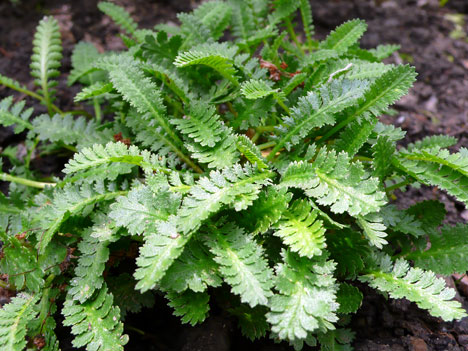
faerie ferns. hopefully they will spread out into a lush carpet of ground cover in my hosta bed, which sits squarely in the shade. in my head i can see it clearly—a cool green carpet of tough little fern fronds completely covering the soil and preventing any weeds at all from growing through.
then a note of realism intrudes: they are just as likely to sit in the little patches exactly where i planted them, not budging a centimeter. but you never know . . . some plants do thrive and respond as they should. the little pot of epimedium rubrum which i purchased two years ago has spread and spawned more new growth than i dreamed possible
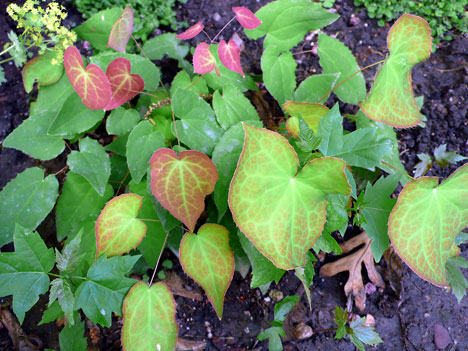
and now i divide it gleefully each spring to plant it wherever i need some filler. i think i have a dozen good-sized patches of it now. it’s not as low-to-the-ground as i’d like though, so i’m trying the faeirie ferns in places where i’m still seeing lots of weeds, despite the shade.
i’ve spent the better part of my gardening hours this week making a dent in the weeds. we’ve have nearly-perfect weather for gardening . . . good solid rain on some days, interspersed with hot sunny days in between. plenty of water and sun for the plants—and the weeds love it too. it’s that time of year when you can turn around start right over again once you’re done.
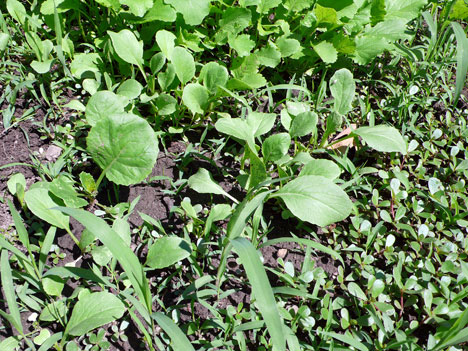
today i tackled the greens bed. while not a large area, for some reason it has the highest concentration of weed growth. i’m sure there is an answer for this, but i don’t know what it is. do some plants attract weeds more than others?
take the purslane for example (lower right corner in photo above)—it is insidious here, and i am repeatedly struck dumb by its genius in spawning multitudes of itself, especially in hard-to-weed places, like the herb and greens beds (and if one more person tells me that this hateful specimen is edible, i just don’t know what i’d say, but i shouldn’t be held responsible). it’s the kind of weed that grows back instantaneously upon removal . . . and i do mean that. i have spent whole evenings cleaning the beds of it, only to discover it growing back while i water afterwards. arrrggh. but i try to be patient.
i worked this morning until the sun got too hot but i got half the bed cleaned out
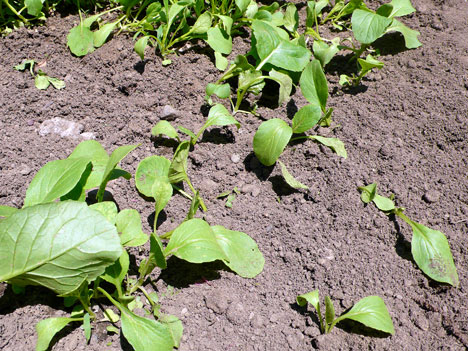
and i’ll work on the rest later this evening. i’m looking forward to getting this done . . looks like there is enough space where seeds didn’t germinate to throw some spinach or swiss chard into those spots.
i have one last thing i need to buy for the yard and i keep not having enough time to do it. i need to get some more awesome coleus and caladium for the front of the house and the planters. i love those kinds of foliage plants, with their weird coloring and shade-loving habits. i just hope i can find some leftovers i like. the few i have are adjusting well
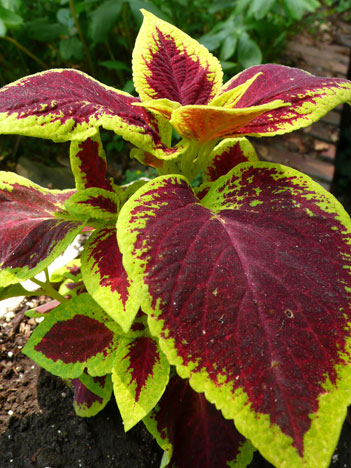
but i need some more to make a display.
speaking of colorful leaves, i finished the leaflet scarf the other day and today i gave it a bit of a blocking
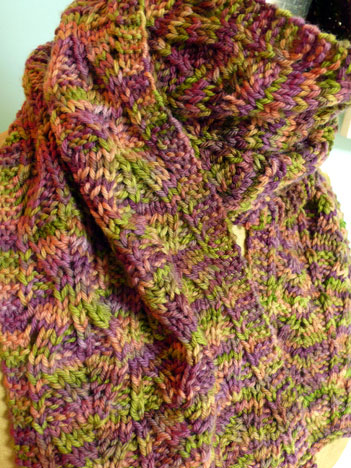
now, i know what you’re going to say . . . that you liked it better unblocked, or that you probably wouldn’t block it. and if i was knitting this just to wear myself, i might not block it either. but i’ve noticed in progress photos that the stitch pattern has a tendency to form horizontal ripples, which look a little unkempt. and the drape isn’t really as nice if i leave it unblocked. so in the quest for the most photogenic fabric, i went for blocking.
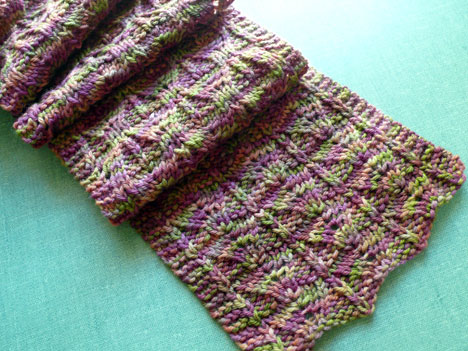
that said, i definitely was not looking to block all the texture out of it—in fact i hoped to preserve as much as i reasonably could. so i felt wet blocking was out, and opted for steam blocking. there is a little bit more ability to mold and play with the fabric when you steam it, during that drying period after it’s been blasted and saturated with vapor.
i thought i’d share the process as best i can . . it was a little hard to photograph since my workroom has some dark spots (most notably over the pressing bench; please excuse the slightly blurry pictures). first i pinned it out gently, without stretching, to straighten the edges on top of a dry, thick towel
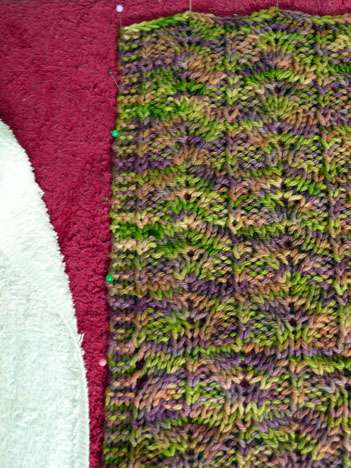
you can use blocking wires, but i was too lazy today to work with them in this tight space. as you can see, i have my white towel nearby which is well-soaked with cold water. my iron is turned on and hot. here is a shot of the texture beforehand
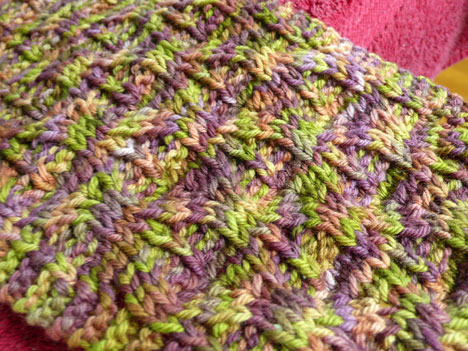
i laid the wet towel over the pinned-out scarf, and without applying any pressure, i touched the raised surface of the towel with the hot iron, causing a blast of steam to shoot down through to the scarf. i held the iron there a few seconds and moved on to the next spot. it is VERY important not to apply pressure to the fabrics at all—the goal here is to create steam only, while providing an airspace over the knit fabric to trap that steam so it can permeate the yarn.
when i lifted the towel away, the texture had changed somewhat
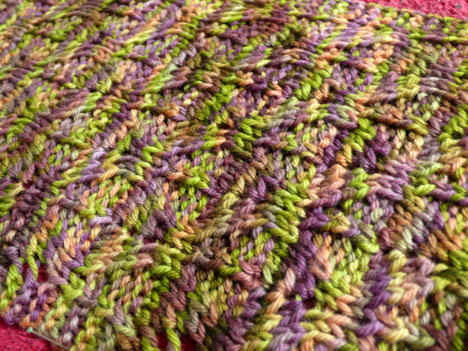
and the surface of the fabric had lost its slightly-rumpled look, to take on a nice smooth appearance. it’ important to allow the steamed piece to lie pinned until the fabric is dry again. ths takes about 10-15 minutes, depending on the weather—the perfect amount of time to get my ten minutes of spinning in (thanks for the tip carole!)

(i’ve been trying to find little moments for this alpaca top i bought at wooster, and which i started spinning in class last weekend. ten minutes a day isn’t going to get it spun very fast, but at least it’s something . . . and the spinning wheel is just a few feet away)
ok, back to the pressing bench—here is a shot of one blocked scarf half with the other unblocked, for comparison
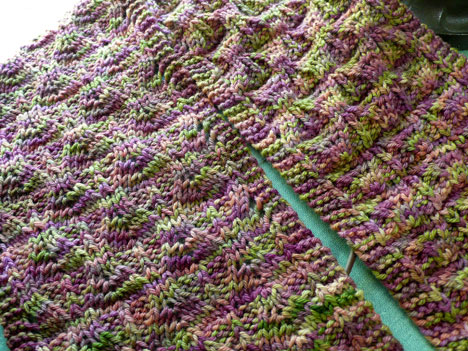
as i said, it’s purely a matter of taste which way you want to go with it, but for my purposes, i feel the nice neat edges and unwrinkled look do the piece more justice in photos. there’s enough texture showing to know what the possibilities are.
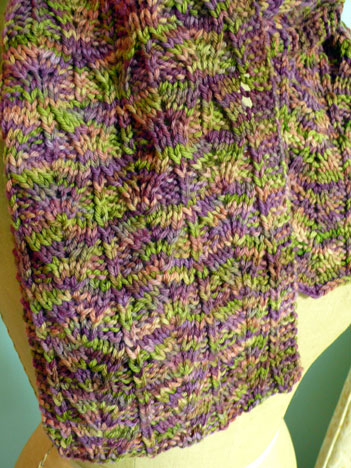
and if you block it and don’t care for it, you can dampen it and allow it to relax back a little. wool is very malleable—if one thing doesn’t work, another might. the only thing you don’t want to do with it is press so hard that you crush the yarn and put permanent creases in it.
blocking is NOT pressing. blocking is allowing the yarn to soak up moisture so that the fibers are weakened enough to be stretched or otherwise molded, then allowing the fiber to return to its natural moisture level while held in this controlled shape. often this encourages the fiber to bloom and its natural twist (which gets distorted by knitting and handling) to return. blocking is a coaxing process more than a “beating into submission” process, and one which allows a margin for changing and remolding.
there are different types of blocking and which type you choose depends on what your aims are. certainly, we’ve all chosen an unwise method at times, but thankfully, you can rework it if something goes pear-shaped.
ok, lesson over! i need to get back to this monster of a pattern i’m writing (that is, it’s big, not ugly). i spent all day on it yesterday and now i see a glimmer at the end of the tunnel (vanessa, it’s on its way). and i’d like to actually do some knitting . . .
i put a few repeats on this baby last night and if i get in from the garden early enough (must get back to that weeding too), i just might finish it up tonight.
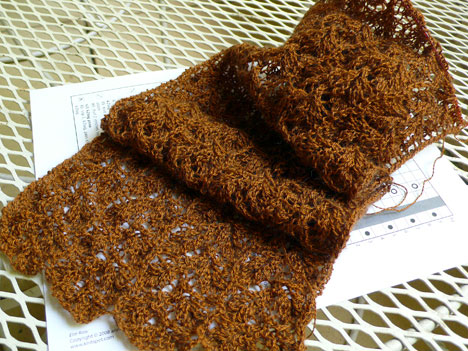
i dunno though . . . that could be a stretch. things don’t look promising


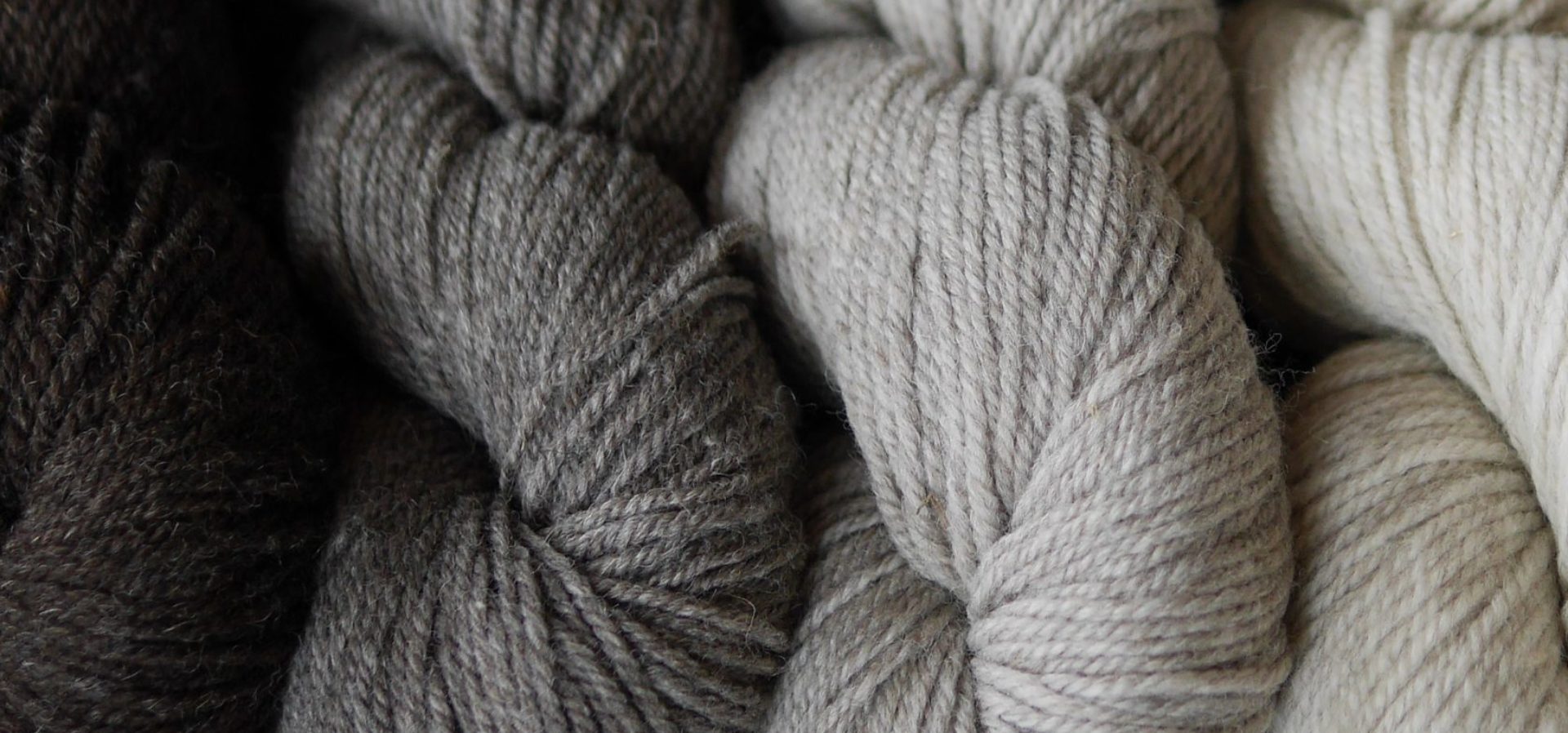
32 thoughts on “today i’m a blockhead”
Oh yay. I love your garden shots. Especially since I’m away from home this summer and can’t have a garden of my own. So I’m imagining that yours is mine. Gosh, it sure is nice to have someone do the weeding! 🙂 (And by the way–purslane tastes like crap. If that makes you feel any better.)
Love the new scarf! It looks so cozy and comfy.
This is vicarious gardening at it’s best. I just finished working at my computer for the day and because I have quite a bit of work ahead of me this week and won’t get outside much, yuck, it is lovely to visit your garden with you. I have 2 big maples in my front yard which retard grass growth and yesterday I noticed that the clover I seeded is finally filling in the bare spots. Cushy looking patches with tiny green sprouts. They make me smile. I could probably use some of your weeds which won’t die.
“Mary, Mary, quite contrary, how does your garden grow?” Now, we know!! I feel as though I’m tending a virtual garden! The scarf is lovely, and yes, unblocked is my preference for it, but I learned a lot reading your post, not to mention I had just listened to a podcast on blocking this morning. Will wonders never cease?!!
Wow did you ever get a lot of gardening done!
I think the scarf was blocked just right, it looks great!
Love the garden photos, even the weeds!
I just made a contribution to Claudia’s MS fundraiser; letting you know so you can contribute also and thanks for promoting on your blog. Hugs
You can buy seed packets for the coleus and caladium.
I’m just back from a week in California and the garden needs a lot of attention. I’m going to be pulling purslane from around the potatoes. I trimmed back the catnip today which grows like a weed here, but at least it’s a weed that our cats love.
I love the family resemblance between the coleus and the scarf!
My sister in Massachusetts has a big, well established, almost completely shaded hosta bed on the east side of her house under the maples and she’s let violets fill in between the hostas. She also stuck a bleeding heart (?) in the one sunny spot in that bed, against the house, for some height and color.
I love your coleus photo! I have some shade here. Maybe I’ll look into some nice bright plants like that for it.
Fun fact of the day: 98% of the world’s Caladiums come from Lake Placid, Florida.
http://www.lpfla.com/about/caladium.htm
I bet if you start eating the purslane that it will stop growing out of perversity.
I love the finished scarf!! I like it both blocked and unblocked! Perverse, huh? 🙂
Do you mind me asking which yarn you used. I really love the colours 🙂
Thanks for the blocking explanation… steam blocking has been a mystery for so long but I’ll have to try it next time.
I’d come up and get your purslane at any time. But then I’m about to get on a motorcycle for a 2000 mile round trip to Minnesota for a wild food summit. Go figure! Call me crazy – I hear it all the time.
I have packed 2 projects though – violets rising and alhambra. Should keep me occupied for the evenings when I stop. That is if I don’t just fall into bed.
Weeds…the never ending garden battle! It looks like you made a good dent in cleaning them out though.
I am really loving the newest little scarf.
So many weeds so little time! I love your scarf and thanks for the blocking tips.
I enjoy your knitting, as well as your garden. Coleus responds extremely well to pinching, and I often take tip cuttings of a good 4 inches and root them directly in soil (H2O also works). They root very quickly.
do you eat the purslane? It’s way yummy in salads.
I love seeing your garden as it grows (weeds and all!). I want to be the sort of person who gardens, but all attempts to make myself into one have proven futile, so I’ll live vicariously 🙂 The scarf looks great — I think that the blocking really allowed it to shine. And that new little nothing is gorgeous!
I’ll eat your purslane. Or call it quelites, if it helps, and make tacos with it. But I don’t think it’s edible for you.
An interesting book: Sara Stein, My Weeds: A Gardener’s Botany
For help understanding why they’re impossible to eradicate. And a good read.
For a moment I had the burgundy and green leaves photo and the first scarf photo on the screen together. Looks like one was spun from the other. Well, sort of.
Your garden looks beautiful! If I could knit even A fourth as well as you do I would be happy,thank you for the tips. Beth
Usually I’m one who loves it more before it’s blocked, but I have to say that one looks so much better AFTER. I also think it’s a great stitch pattern for variegated yarn. Pretty!
Well, I think blocking improves any knitted garment! And your scarf is no exception. It looks crisp and elegant. And how well it coordinates with your foliage plants! 😀
Purslane is indeed edible and really good for you. In Greek it’s called “glistritha” (a hard th sound)meaning slippery. I ate it a lot as a kid with a bit of salt, oil and lemon juice. Unfortunately the stuff that pops up here gets attacked by leaf miners by the time I find it.
Love the scarf! Is that Briar Rose Chris’ yarn?
Thank you for the steam-blocking info! I did not realize one needs to put a towel on top, and the details help it make a lot more sense to me now.
At first I thought I didn’t like the reduction of texture, but after seeing the comparison shot–I prefer the blocked version, and probably would in person, too.
Still love this scarf and am thrilled you knit it up. The colors are smashing. Looking forward to the next one just as much (and also this big secret project… the tantalizing hints are killing me!)
Wow, thanks so much for the info on blocking! I’m going to block a project for the first time pretty soon, and this really helped me understand what blocking is and how it works. I feel a lot more confident about it now!
Love all your gardening photos…and thanks for the blocking info.
BTW, I made a donation to Claudia’s MS ride, so you can use up some more of your matching donation funds!
Wow, I realize that this post was all about blocking and gardening, but I’m particularly struck with your spinning! Your singles are so thin and uniform!!! I’m a spinning newbie (obviously!), just learned on a drop spindle, and I’m not sure whether it’s my cup of tea or not. Still, I love the idea of spinning, you know? I think I need to try spinning on a wheel before I make up my mind one way or the other…
Thanks for the tutorial on blocking. I do like the scarf after blocking as it evens out the stitches & there is still enough tecture on it. Love the scarf & it’s colors.
wonderful blocking tips – thank you… there is always more to be learned. The scarf looks lovely both ways.
So you’re spinning too! yay! I did a tiny bit last week, and it felt so wonderful.
Puslane=bleh.
I’m not even sure what to comment about. I love the garden shots. I am an avid gardener, aided significantly by living in an almost ideal gardening climate. I subscribe to the “no bar earth” theory of gardening. I plant all my beds with multiple layers of plants so that there is (obviously) no dirt showing. I have virtually no weeds because there is nowhere for them to grow.
I also love that coleus colored scarf. The yarn and pattern are both gorgeous!
“Bare earth”. Not “bar”. Duh.
Comments are closed.